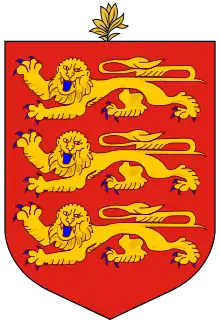The island of Guernsey has been fortified for several thousand years, the number of defence locations and complexity of the defence increasing with time, manpower and the improvements in weapons and tactics.
Being in the front line of many wars, invasion was almost always a threat and the best locations for defence were being constantly rebuilt with older constructions being re-used and improved.
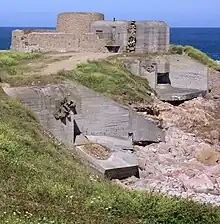
Early defences
The first form of defences comprised safe locations for the islanders to flee to in the event of an invasion. The headland at Jerbourg, the Castel fortress, the Chateau des Marais and the Vale Castle were probably the earliest.

- The Jerbourg Point defences resembled an Iron Age fort, it comprises a series of ditches and banks across the neck of the headland, providing a short defensive wall behind which the people could retreat in times of danger. Dating from 2,000 B.C. the Jerbourg defence of three ditches was improved, firstly with stone reinforcing[1]: 99 and later with wooden platforms, palisades and a tower, however it fell to French invaders in 1338.
- Nothing remains of the Castel fortress, apart from the parish name "Castel", or castle. It is suspected to date from Roman or Viking times and is thought to be located under the parish church.
- Chateau des Marais, also called locally "Ivy Castle" built in a swamp, a "marais", using the natural wetland, supplemented with banks and ditches for defence built in the 12th century.[1]: 144 as a standard Motte and Bailey fort.[2]
- The castle of Saint Michael or as it is now called "Vale Castle", dating from the Iron Age, was constructed to protect the population against pirates by providing a safe refuge. It is not possible to identify when the medieval works were started, possibly in the late 10th-century.[3]: 130–1
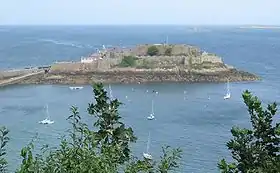
Castle Cornet was started in the late 13th Century on an islet accessible at low tide, outside Saint Peter Port.[1]: 144–7 It would serve as the main base for the Governor of Guernsey, the commander of the Island's military forces, for many centuries.
The Guernsey militia was formed in 1337 and would continue until disbanded in 1946. It was compulsory for all men to belong to the militia. They trained weekly and for six centuries provided the main defensive force for the island.
A French invasion in 1338 captured the whole island including Castle Cornet, which dates back to at least 1256. Two years later the island was recaptured by English forces after the French navy was crippled at the Battle of Sluys and in August 1345 Castle Cornet was also recaptured. 13 years later the castle was again captured by the French before being evicted the following year.
In 1350 the King Edward ordered walls to be constructed around the town. The order was repeated when the work was not undertaken, but no evidence has been found of their existence. They would have linked the Tour Gand to the north with the Beauregard tower in the south.[4]
In May 1372 Owain Lawgoch a claimant to the Welsh throne, at the head of a free company, on behalf of France, attacked Guernsey, popularly called "La Descente des Aragousais". Owain Lawgoch withdrew after killing 400 of the Island militia,[5] The poem of the same name refers to the Vale Castle as the Château de l'Archange, the location of the last ditch stand against the insurgents.[6]: 34
With the advent of cannon and gunpowder, defences, now based mainly around Castle Cornet were remodelled between 1545 and 1548.
During the Third English Civil War, Castle Cornet, the main fortification in the island, supported the King whilst the island supported Parliament, this resulted in a siege of the castle that lasted nine years, ending in 1651. The castle had been improved over the centuries with added walls, gates and batteries.
The King's Survey of the Channel Islands was commissioned by Charles II in 1679. The report produced by Colonel Legge a year later was a comprehensive account of the state of defence, harbours and civil jurisdiction of the Islands. In Guernsey, defences had been poorly maintained, Castle cornet having suffered a major explosion after a lightning strike in 1672.[7]
Main early defences, starting from St Peter Port and moving in a clockwise direction.
| Parish | Place/Name | Notes | Coordinates |
|---|---|---|---|
| St Peter Port | Castle Cornet ‡ £ | Main defence, built on islet and constructed of granite | 49°27′10.8″N 2°32′15.7″W / 49.453000°N 2.537694°W |
| St Peter Port | Town Walls | possibly built around 1350 [8] | 49°27′14.3″N 2°32′10″W / 49.453972°N 2.53611°W |
| St Peter Port | Gand tower | existed in the Pollet area, La Tourgand [4] | 49°27′28″N 2°32′7″W / 49.45778°N 2.53528°W |
| St Peter Port | Beauregard tower | built in 1357 on Mignot Plateau, now demolished | 49°27′12.4″N 2°32′14.4″W / 49.453444°N 2.537333°W |
| St Martin | Jerbourg headland ʘ | earthen ditches and banks to protect headland [1] | 49°25′37.2″N 2°31′58.8″W / 49.427000°N 2.533000°W |
| Torteval | Pezeries ‡ ʘ | Fort first mentioned in 1680 [9] | 49°26′13.5″N 2°40′16.8″W / 49.437083°N 2.671333°W |
| Castel | Hommet headland – Fort Hommet ʘ | fortification recorded in 1680 with one gun | 49°28′27.8″N 2°36′44.1″W / 49.474389°N 2.612250°W |
| Castel | Inland fortress pre 600 A.D. | possible earth and wood construction now demolished | 49°27′30.7″N 2°34′23.2″W / 49.458528°N 2.573111°W |
| Vale | Le Marchant headland – Fort L’Angle ‡ ʘ | small fort mentioned in 1680, renamed in 1805 Le Marchant | 49°30′32″N 2°31′7.2″W / 49.50889°N 2.518667°W |
| Vale | Vale Castle ‡ ʘ [10] | built on top of a rock outcrop, protected by 15C granite walls | 49°29′6.5″N 2°30′32.9″W / 49.485139°N 2.509139°W |
| St Peter Port | Chateau des Marais ‡ ʘ | built in a swamp, a standard Motte and Bailey fort | 49°28′18.9″N 2°32′19.5″W / 49.471917°N 2.538750°W |
Key ‡ Protected Monument [11] £ Accessible with fee ʘ Accessible
18th and early 19th Century
18th Century threats from France

Having lived with constant threats during the Seven Years' War (1754–63), threats of an invasion from France during the Anglo-French War (1778–83) resulted in additional artillery being brought to the Island and the construction of several forts, numerous batteries covering possible landing sites and fifteen Guernsey loophole towers built between 1778 and 1779,[12] The threat was real as an invasion of nearby Jersey resulted in the Battle of Jersey in Saint Helier in January 1781. Work started in 1782 on the massive Fort George, on the hill south of Town, it would take over three decades to complete. Guernsey granite was used for the majority of the gun platforms, forts and walls with embrasures often lined with brick.
A map was produced in 1787 for the Duke of Richmond as Master-General of the Ordnance to show all existing roads and military positions.
French Revolution and Napoleonic era defences
The French Revolution in 1789 added to the concerns in the Channel Islands and resulted in additional constructions and an increase in manpower.
The island militia of around 3,000 men provided both infantry and coastal artillery units. They were supplemented with regular British infantry battalions who rotated and were increased or reduced depending on the current threat to the island. Before the barracks were built in Fort George, islanders were required to provide accommodation for soldiers that could not be accommodated in Castle Cornet. Each Parish had its quota and if they were quartered in public houses or private dwellings, the parish authorities were liable for the cost.[13]: 59 Non British units, which were not allowed on the UK mainland, were sometimes based in Guernsey, including from 1793 to 1796 French Royalists and in 1799, 6,000 Russian troops, who were quartered at Delancey.[14]: 12 In 1796 Peter de Havilland, a Jurat was appointed superintendent of thirteen signal masts around the island, installed to give warning of approaching ships.[15]: 45
Lieutenant-General John Doyle was appointed Lieutenant Governor of Guernsey in 1803. After declaring a "state of emergency" in 1804,[16] he undertook many works to improve the defence of the Island, including the draining of the Braye du Valle, improving some roads to military standard and building forts and batteries around the coast, including completing Fort George. Major-General Sir John Doyle was supported from 1810 by the new Bailiff, Peter de Havilland. The "emergency" lasted until 1815.
Doyle was instrumental in getting three Martello towers built in 1804–1805, as well as the reclaiming of Braye du Valle 1806–1808, the improved military roads with mile markers, for which he argued eloquently, against much opposition,[17]: 48–58 and barracks which together gave the militia and regular units improved facilities to repel any invasion.[18]
The Royal Navy provided the first line of defence, Captain Sausmarez, in command of a Guernsey-based squadron consisting of three frigates, HMS Crescent (1784), HMS Druid (1783) and HMS Eurydice (1781), a lugger, and cutter frustrated a planned invasion by 20,000 French soldiers of the Channel Islands scheduled for February 1794, due to his vigilant eye[14]: 9 Admiral James Saumarez was again put in charge of a squadron based in Guernsey from 1803 to 1808.
Defences
Land based defences, starting from St Peter Port and moving in a clockwise direction.
| Parish | Place/Name | Notes | Coordinates |
|---|---|---|---|
| St Peter Port | Castle Cornet ‡ £ | harbour defence, now a museum | 49°27′10.8″N 2°31′33.6″W / 49.453000°N 2.526000°W |
| St Peter Port | Havelet – Half Moon battery ʘ | battery covering Havelet bay | 49°27′0.7″N 2°32′5″W / 49.450194°N 2.53472°W |
| St Peter Port | Fort George | large fortress with barracks, built between 1782 and 1814,[18] now a housing estate | 49°26′38.4″N 2°21′16.8″W / 49.444000°N 2.354667°W |
| St Peter Port | Fort George – Clarence battery ‡ ʘ [19] | on headland, named Clarence Battery in honour of George III's son | 49°26′46″N 2°31′48.8″W / 49.44611°N 2.530222°W |
| St Peter Port | Fort George – Adolphus battery | 49°26′33.4″N 2°32′2.8″W / 49.442611°N 2.534111°W | |
| St Peter Port | Fort George – Kent battery | ||
| St Peter Port | Fermain Bay – Becquet battery ‡ [19] | ¤63+64+65 Linked with magazine and watch house | |
| St Peter Port | Fermain Bay – North battery ‡ [19] | ¤62 | 49°26′10.5″N 2°32′9.4″W / 49.436250°N 2.535944°W |
| St Martin | Fermain Bay – Tower 15 Guernsey loophole towers ‡ ʘ | Plans to convert to holiday accommodation [20] | 49°26′9.7″N 2°32′1.3″W / 49.436028°N 2.533694°W |
| St Martin | Fermain Bay – South battery | ¤60 | |
| St Martin | Bec du Nez battery and magazine ‡ ʘ | ¤59 One gun | 49°25′47″N 2°31′53.8″W / 49.42972°N 2.531611°W |
| St Martin | Jerbourg battery ‡ | ¤57+58 built over by later German defences | 49°25′27.1″N 2°31′53.5″W / 49.424194°N 2.531528°W |
| St Martin | Jerbourg – La Moye battery ‡ [19] | ¤56 La Tas de Pois d'Ament battery | 49°25′13.8″N 2°32′20.4″W / 49.420500°N 2.539000°W |
| St Martin | Moulin Huet – Left and Right batteries ‡ ʘ | ¤54+55 | 49°25′27.1″N 2°34′55.7″W / 49.424194°N 2.582139°W |
| St Martin | Saints Bay – Tower 14 ‡ [21] | 49°25′24.8″N 2°33′31.6″W / 49.423556°N 2.558778°W | |
| St Martin | Saints Bay – Left and Right batteries [19] | ¤52+53 With two 24-pounder guns | 49°25′15.8″N 2°33′26.3″W / 49.421056°N 2.557306°W |
| St Martin | Icart Point – battery | ¤51 destroyed | 49°25′11.6″N 2°33′51.8″W / 49.419889°N 2.564389°W |
| St Martin | Petit Bôt – Tower 13 ‡ ʘ [22] | 49°25′33.2″N 2°34′54.8″W / 49.425889°N 2.581889°W | |
| Forest | Petit Bôt – St Claire battery and magazine ‡ ʘ [19] | ¤50 Two 24-pounder guns and magazine | 49°25′27.2″N 2°34′56.4″W / 49.424222°N 2.582333°W |
| Forest | Moye watch house | 49°25′19″N 2°35′12.4″W / 49.42194°N 2.586778°W | |
| St Peter | Prevote watch house ‡ | ¤48 Built over with German tower, granite stones and steps have been reused | 49°25′14.3″N 2°37′8.8″W / 49.420639°N 2.619111°W |
| Torteval | Les Tielles – Battery and watch house ‡ [19] | ¤47 Three gun emplacements | 49°25′29.6″N 2°38′21.6″W / 49.424889°N 2.639333°W |
| St Peter | Mont Herault watch house ‡ | ¤46 manned by militia overnight | 49°25′31.2″N 2°39′21.6″W / 49.425333°N 2.656000°W |
| Torteval | Pleinmont watch house ‡ ʘ | ¤45 mentioned in Victor Hugo's book 'The Toilers of the Sea' house destroyed by German troops |
49°25′38.8″N 2°40′5.5″W / 49.427444°N 2.668194°W |
| Torteval | Narron or Narrow Point Battery ‡ ʘ [19] | ¤44 One 9-pounder gun position, suffering erosion from the sea | 49°26′4.2″N 2°40′27.1″W / 49.434500°N 2.674194°W |
| Torteval | Pleinmont or Petit Portes Battery ‡ ʘ [19] | ¤43 Granite battery for one 18-pounder gun | 49°26′7.8″N 2°40′25.3″W / 49.435500°N 2.673694°W |
| Torteval | Pezeries fort and battery ‡ ʘ [9][23] | ¤42 Three gun battery and magazine in star fort | 49°26′13.5″N 2°40′16.8″W / 49.437083°N 2.671333°W |
| St Peter | Château de Rocquaine – Fort Grey ‡ £ [23] | Martello tower built 1804 now a museum | 49°26′21″N 2°39′18.2″W / 49.43917°N 2.655056°W |
| St Peter | Rocquaine Bay – Brock battery | ¤41 Built over by Germans in WW2 | 49°26′38.6″N 2°38′58.2″W / 49.444056°N 2.649500°W |
| St Peter | L’Eree Point – Battery ‡ ʘ [19] | ¤40 Two guns on granite battery site, magazine | 49°27′21.1″N 2°39′31.4″W / 49.455861°N 2.658722°W |
| St Peter | L’Eree Point – Fort Saumarez ‡ | Martello tower now used as foundation for German observation tower | 49°27′27.2″N 2°39′21.5″W / 49.457556°N 2.655972°W |
| St Saviour | Le Catioroc – Mont Chinchon battery, magazine ‡ ʘ and watch house | ¤38+39 Two gun battery with magazine and ¤39 watch house behind on hill [24] | 49°27′37.6″N 2°38′33.4″W / 49.460444°N 2.642611°W |
| St Saviour | Perelle – battery ‡ ʘ [19] | ¤37 Two gun battery, magazine | 49°27′35.1″N 2°38′3.4″W / 49.459750°N 2.634278°W |
| St Saviour | Perelle – Fort Richmond ‡ | Fort and barracks, now a private house | 49°27′50.5″N 2°37′48.2″W / 49.464028°N 2.630056°W |
| Castel | Vazon – Mouillin or Left battery and magazine ‡ | ¤34 Destroyed by German WW2 defences, magazine intact | 49°27′47.3″N 2°37′14.4″W / 49.463139°N 2.620667°W |
| Castel | Vazon – Tower 12 and Right battery ‡ ʘ [25] | ¤31 Magazine | 49°28′7″N 2°36′23.4″W / 49.46861°N 2.606500°W |
| Castel | Hougue battery ‡ ʘ [19] | two 24-pounder guns (originally 3) | 49°28′1.4″N 2°35′53.4″W / 49.467056°N 2.598167°W |
| Castel | Hommet headland – Fort Hommet ʘ [23] | ¤30 Martello tower built 1804 with batteries for six guns | 49°28′27.8″N 2°36′44.1″W / 49.474389°N 2.612250°W |
| Castel | Albecq – Burton battery ‡ ʘ [19] | ¤29 Two gun battery with alternate positions and magazine | 49°28′29.3″N 2°35′59.2″W / 49.474806°N 2.599778°W |
| Castel | Le Guet –Rocque de Guet watch house ‡ ʘ [26] | ¤28 Built in 1780 | 49°29′15″N 2°35′39.4″W / 49.48750°N 2.594278°W |
| Castel | Cobo – South battery and magazine ‡ [27] | ¤26+27 Battery destroyed when road built, but magazine remains intact ʘ | 49°28′31.3″N 2°35′36.4″W / 49.475361°N 2.593444°W |
| Castel | Grandes Rocque – fort and battery ‡ ʘ [19] | ¤23 Battery held three 24-pounder guns and magazine | 49°29′17.7″N 2°35′19.7″W / 49.488250°N 2.588806°W |
| Vale | Portinfer – battery ‡ ʘ [19] | ¤22 One 20-pounder gun position | 49°29′22.3″N 2°34′41.3″W / 49.489528°N 2.578139°W |
| Vale | Rousse – Tower 11 and battery ‡ ʘ [28] | ¤21 Museum | 49°29′52.6″N 2°33′14.5″W / 49.497944°N 2.554028°W |
| Vale | Chouet – Tower 10 ‡ ʘ [29] | 49°30′16.2″N 2°32′49.2″W / 49.504500°N 2.547000°W | |
| Vale | La Lochande Battery ‡ [19] | 49°30′18″N 2°32′53.5″W / 49.50500°N 2.548194°W | |
| Vale | Pembroke – Pembroke fort ‡ ʘ and Platon battery [19] | ¤18 One 20-pounder gun | 49°30′27.4″N 2°31′55.4″W / 49.507611°N 2.532056°W |
| Vale | Pembroke – star fort ‡ [23] | built 1811, some evidence of earthworks | 49°30′20.5″N 2°32′1.8″W / 49.505694°N 2.533833°W |
| Vale | Pembroke – Tower 9 ‡ ʘ | 49°30′22.1″N 2°32′4.1″W / 49.506139°N 2.534472°W | |
| Vale | L'Ancresse – Tower 8 | demolished | |
| Vale | L’Ancresse – Half Moon and centre batteries | ¤15+16 demolished | |
| Vale | L’Ancresse – Tower 7 ‡ ʘ | 49°30′7.9″N 2°31′51.4″W / 49.502194°N 2.530944°W | |
| Vale | L’Ancresse – Tower 6 ‡ ʘ | 49°30′4.6″N 2°31′35.9″W / 49.501278°N 2.526639°W | |
| Vale | L’Ancresse – Tower 5 ‡ ʘ | 49°30′9.7″N 2°31′20.4″W / 49.502694°N 2.522333°W | |
| Vale | L’Ancresse – Nid de L’Herbe battery ‡ ʘ [19] | ¤14 Three gun battery with magazine | 49°30′11.9″N 2°31′21.8″W / 49.503306°N 2.522722°W |
| Vale | Le Marchant headland – Fort le Marchant ‡ ʘ [23] | ¤13 small fort expanded in 1805 | 49°30′32″N 2°31′7.2″W / 49.50889°N 2.518667°W |
| Vale | Le Marchant headland – Tower 4 ‡ ʘ | 49°30′23″N 2°31′4.5″W / 49.50639°N 2.517917°W | |
| Vale | Fort Doyle ‡ ʘ [23] | Small fort and battery built 1805 | 49°30′21.6″N 2°30′19.3″W / 49.506000°N 2.505361°W |
| Vale | Beaucette battery [19] | ¤12 Two 18-pounders upgraded to 20-pounder guns, magazine demolished by quarrying | |
| Vale | Bordeaux old battery | demolished by quarrying | |
| Vale | Vale Castle ‡ ʘ | Old walled fort on small hill [10] | 49°29′6.5″N 2°30′32.9″W / 49.485139°N 2.509139°W |
| St Sampson | Mont Crevelt – Tower 3 and battery ‡ | ¤9 small fort with tower and battery protecting harbour | 49°28′49.9″N 2°30′48.6″W / 49.480528°N 2.513500°W |
| St Sampson | Belle Greve Bay – Spur point, and Kempt batteries | Spur point on private land, Kemp has been destroyed | 49°28′34″N 2°31′13.8″W / 49.47611°N 2.520500°W |
| St Sampson | Belle Greve Bay – Tower No 2 | demolished in 1958 | 49°28′21.6″N 2°31′58″W / 49.472667°N 2.53278°W |
| St Sampson | Belle Greve Bay – Belle Greve battery | ¤5 demolished | |
| St Peter Port | Chateau des Marais ‡ ʘ | magazine built inside castle | 49°28′18.9″N 2°32′19.5″W / 49.471917°N 2.538750°W |
| St Sampson | Hougue-a-la-Pere – Tower No 1 and battery ‡ | ¤4 tower demolished in 1905,[30]: 22 battery intact | 49°28′11.1″N 2°32′3″W / 49.469750°N 2.53417°W |
| St Peter Port | Salerie battery ʘ | ¤1 now a car park | 49°27′46″N 2°31′55.4″W / 49.46278°N 2.532056°W |
Key ‡ Protected Monument [11] £ Accessible with fee ʘ Accessible ¤1850 list and battery number[31]: 182
Post Napoleonic
In 1819 a Picquet House was constructed near the Town Church, its purpose being to provide a harbour side military presence and a lockup for unruly persons.[30]: 13
Victorian era
In 1850 a letter was presented to Queen Victoria listing the defences on the island.[31] During the Victorian era, defence improvements mainly consisted of replacing the Napoleonic cannon with breach loading heavier artillery in the 1870s and modifying forts to take a smaller number of the larger calibre guns. Many of the older batteries were decommissioned. A number of new military buildings were also built.
The militia received updated breach loading rifles in 1870. Drab khaki service dress was issued in 1902 when the militia size was reduced to 1,000 men during times of peace.[32]
Some defensive positions were improved with a small glacis, whilst making the gun positions less obvious to an attacker.
Building works in the Victorian period starting from St Peter Port and moving in a clockwise direction.
| Parish | Place/Name | Notes | Coordinates |
|---|---|---|---|
| St Peter Port | Castle Cornet ‡ £ | improved artillery | 49°27′10.8″N 2°32′15.7″W / 49.453000°N 2.537694°W |
| St Peter Port | Arsenal | store for mobile artillery built in 1850 and the Militia headquarters, now the Island fire station |
49°27′31.1″N 2°32′35.3″W / 49.458639°N 2.543139°W |
| St Peter Port | Clarence battery ‡ ʘ | improved artillery | 49°26′46″N 2°31′48.8″W / 49.44611°N 2.530222°W |
| Castel | Fort Hommet ʘ | improved artillery and barracks built 1856 | 49°28′27.8″N 2°36′44.1″W / 49.474389°N 2.612250°W |
| Vale | L’Ancresse Bay – Pembroke Fort ‡ ʘ | improved artillery | 49°30′27.4″N 2°31′55.4″W / 49.507611°N 2.532056°W |
| Vale | Fort Le Marchant ‡ ʘ | improved artillery and barracks built 1854 | 49°30′32″N 2°31′7.2″W / 49.50889°N 2.518667°W |
| Vale | Fort Doyle ‡ ʘ | upgrade for improved artillery | 49°30′21.6″N 2°30′19.3″W / 49.506000°N 2.505361°W |
| St Peter Port | Bréhon Tower ‡ | sea fort built by 1856 | 49°28′16.5″N 2°29′17.3″W / 49.471250°N 2.488139°W |
| Various | Four militia arsenals built in 1882 | Le Bordage (Baubigny), St. George (les Beaucamps), Les Naftiaux and St. Peter-in-the-Wood (Les Islets) |
Key ‡ Protected Monument [11] £ Accessible with fee ʘ Accessible
World War I
First World War defences saw just one innovation, the establishment of a French seaplane base, on the pier close to Castle Cornet, in St Peter Port. The pilots flew on constant watch for German submarines.[33]
The rules regarding the militia were changed to suspend the force, the volunteering men were partly scattered amongst British units, the main force was converted into the Royal Guernsey Light Infantry. The island's men went off to war, most to fight in France.
War trophies of four German 13.5 cm K 09 artillery guns were displayed next to Victoria Tower until two were scrapped in 1938 and in 1940 the remaining two were buried in case enemy aircraft suspected they were "live". Forgotten about, they were uncovered in 1978 and are again on display.[34]
World War II
The island was demilitarised in June 1940 including suspending the militia again. During the German occupation which ran from June 1940 to May 1945 a massive building programme was instigated by Germany which saw the construction of tunnels, anti-tank sea walls, coastal casemates, artillery positions, artillery observation towers, radar units and a mass of trenches, minefields and barbed wire entanglements.
Up to 7,000 Organisation Todt workers in Guernsey built mainly in two years, between 1941 and 1943, the bulk of the fortifications. The German Festung Guernsey book recorded 616,000m³ of concrete used in Guernsey,[35] almost 10% of the concrete used in the Atlantic Wall.
Of the eleven artillery batteries on Guernsey, the largest was located in Batterie Mirus, comprising four 30.5 cm guns which had a range of 51 kilometres (32 mi).[36]
Camouflage was used in defensive works by German engineers, as were burying or part burying structures to escape aerial observation and attack. Many guns were designed to fire at an angle across a potential danger area rather than facing the sea, where they would be susceptible to direct fire from ships. The thickness of the concrete walls and roofs of the German structures providing adequate protection for weapons developed by 1944.
Many constructions are on private land and not accessible to the public, others may be looked at, clambered over and a few can be entered with care. Those that can be visited include:
| Parish | Place/Name | Notes | Coordinates |
|---|---|---|---|
| St Peter Port | Castle Cornet ‡ £ | Hafenschloss ("Harbour Castle") now a museum | 49°27′10.8″N 2°32′15.7″W / 49.453000°N 2.537694°W |
| St Peter Port | St Jacques ‡ £ | Naval Signals HQ, now a museum [37] | 49°27′39.8″N 2°32′46.7″W / 49.461056°N 2.546306°W |
| St Peter Port | La Vallette tunnels £ | Tunnels used to store fuel, now a museum | 49°26′53.7″N 2°31′52.9″W / 49.448250°N 2.531361°W |
| St Andrew | "Ho.7/40" tunnels £ [38] | Large tunnel complex, now the underground hospital museum | 49°26′31.8″N 2°34′35.2″W / 49.442167°N 2.576444°W |
| Forest | German Occupation Museum £ | Main island museum relating to the occupation period | 49°25′46″N 2°35′35.4″W / 49.42944°N 2.593167°W |
| Torteval | "Battery Dollmann" ʘ | Restored German 22 cm battery | 49°25′37.6″N 2°40′3.9″W / 49.427111°N 2.667750°W |
| Torteval | "Observation Tower MP3" £ | Artillery observation tower now a museum | 49°25′57.3″N 2°40′17.2″W / 49.432583°N 2.671444°W |
| St Peter | L’Eree headland trenches ʘ | re-excavated trench system | 49°27′27.3″N 2°39′22.8″W / 49.457583°N 2.656333°W |
| Castel | Fort Hommet 10.5cm Casement ‡ £ | Renovated beach defence area now a museum | 49°28′24.2″N 2°36′33.7″W / 49.473389°N 2.609361°W |
| Vale | L’Ancresse ʘ | Assorted bunkers on the common and nearby anti tank wall | 49°30′13″N 2°31′7.7″W / 49.50361°N 2.518806°W |
| Vale | Vale Castle ‡ ʘ | German modifications to older castle | 49°29′6.5″N 2°30′32.9″W / 49.485139°N 2.509139°W |
Key ‡ Protected Monument [11] £ Accessible with fee ʘ Accessible
Cold War
Castle Cornet provided an underground control bunker, using the WW2 German concrete construction, which would, in the event of war, control shipping in the western end of the English Channel.[39]
Gallery
 An old print of Castle Cornet c. 1814.
An old print of Castle Cornet c. 1814.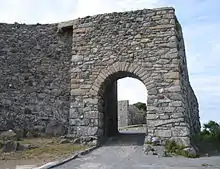 Vale Castle entrance
Vale Castle entrance Tower No 5
Tower No 5 Towers on L'Ancresse
Towers on L'Ancresse Tower 12 at Vazon
Tower 12 at Vazon Tower 15 at Fermain Bay
Tower 15 at Fermain Bay Mont Chinchon battery
Mont Chinchon battery Fort Grey
Fort Grey Fort George (1)
Fort George (1) Fort George (2)
Fort George (2) Fort George (3) Charlotte Battery gate
Fort George (3) Charlotte Battery gate Fort Sausmarez
Fort Sausmarez Fort Pezeries
Fort Pezeries Fort Pezeries magazine
Fort Pezeries magazine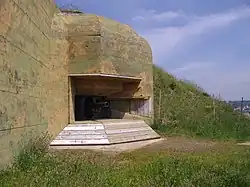 German 10.5 cm Casement
German 10.5 cm Casement
See also
External links
References
- 1 2 3 4 Sebire, Heather. The Archaeology and Early history of the Channel Islands. NPI Media Group. ISBN 978-0752434490.
- ↑ "Chateau des Marais". BBC. 24 September 2014.
- ↑ Berry, William. The history of Guernsey from the remotest period of antiquity to the year 1814.
- 1 2 Lempriére, Raoul. History of the Channel Islands. Robert Hale Ltd. p. 33. ISBN 978-0709142522.
- ↑ The Guernsey and Jersey Magazine, Volumes 1–2. 1836. p. 169.
- ↑ Marr, James. Bailiwick Bastions. Guernsey Press. ISBN 0 902550 11X.
- ↑ "The Legge Report, or King's Survey of the Channel Islands, 1680". Priaulx Library.
- ↑ "ST PETER PORT TOWN DEFENCES". Gatehouse.
- 1 2 "Pezeries". The Sarnian.
- 1 2 "History of the Vale Castle". BBC. 13 November 2014.
- 1 2 3 4 "Protected Monuments". Guernsey government.
- ↑ "Towers". Guernsey Museum.
- ↑ Crossan, Rose-Marie (2015). Poverty and Welfare in Guernsey, 1560–2015. Boydell Press. ISBN 978-1783270408.
- 1 2 Cox, Gregory Stevens (July 1989). Guernsey & the French Revolution. Guille Alles Library.
- ↑ Hocart, Richard (1977). Peter de Havilland: Bailiff of Guernsey : a history of his life, 1747–1821. Société Guernesiaise.
- ↑ "General Sir John Doyle". BBC. 24 March 2009.
- ↑ Biographical Sketch of the Honourable Lieutenant-General Sir John Doyle. T Greenslade, Guernsey. 1 November 1806.
- 1 2 Lempriére, Raoul. History of the Channel Islands. Robert Hale Ltd. p. 130. ISBN 978-0709142522.
- 1 2 3 4 5 6 7 8 9 10 11 12 13 14 15 16 17 18 19 "Gun Batteries". Guernsey Museums.
- ↑ "Fermain Tower Accommodation Plans Revealed". Island FM. 28 April 2017.
- ↑ "Saints tower No 14". Guernsey museum.
- ↑ "Petit Bôt tower No 13". Guernsey museum.
- 1 2 3 4 5 6 "Forts". Guernsey museum.
- ↑ "Mont Chinchon". BBC. 13 November 2014.
- ↑ "Vazon tower No 12". Guernsey museum.
- ↑ "Watchhouses". Guernsey museum.
- ↑ "Magazines". Guernsey museum.
- ↑ "Rousse tower No 11". Guernsey museum.
- ↑ "Chouet tower No 10". Guernsey museum.
- 1 2 Toms, Carel (2003). St Peter Port, People & Places. ISBN 1 86077 258 7.
- 1 2 Girard, Peter (1990). More of Peter Girard's Guernsey: A Second Miscellany of Guernsey's History and Its People. Guernsey Press. ISBN 978-0902550421.
- ↑ Ogier, Darryl. The Government and Law of Guernsey. States of Guernsey. p. 212. ISBN 978-0-9549775-1-1.
- ↑ "WW1 submarine hunters: French seaplane base in Guernsey". BBC. 6 August 2014.
- ↑ "The Guernsey Guns" (PDF). Great War CI.
- ↑ "History:Fortifying Guernsey". Festung Guernsey. Archived from the original on 9 April 2016.
- ↑ "Batterie Mirus". Festung Guernsey. Archived from the original on 7 March 2016. Retrieved 12 August 2016.
- ↑ "St Jacques Naval Headquarters". CIOS. Archived from the original on 3 May 2013. Retrieved 12 August 2016.
- ↑ "German Military Underground Hospital". BBC. 24 September 2014.
- ↑ "Guernsey Castle Cornet Cold War rooms opened to public". BBc. 1 April 2016.
